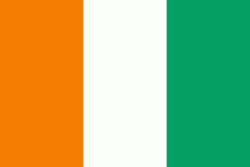Sassandra Department (Sassandra)
Sassandra Department is a department of Gbôklé Region in Bas-Sassandra District, Ivory Coast. In 2021, its population was 353,228 and its seat is the settlement of Sassandra. The sub-prefectures of the department are Dakpadou, Grihiri, Lobakuya, Médon, Sago, and Sassandra.
Sassandra Department was created in 1969 as one of the 24 new departments that were created to take the place of the six departments that were being abolished. It was created by taking territory from both Centre-Ouest Department and Sud Department. Using current boundaries as a reference, from 1969 to 1980 the department occupied the same territory as Bas-Sassandra District, with the exception of Fresco Department (ie, all of Nawa, San-Pédro, and Gbôklé Regions save Fresco Department).
In 1980, Sassandra Department was divided to create Soubré Department. What remained was divided into three parts in 1988 in order to create San-Pédro and Tabou Departments.
In 1997, regions were introduced as new first-level subdivisions of Ivory Coast; as a result, all departments were converted into second-level subdivisions. Sassandra Department was included in Bas-Sassandra Region.
Sassandra Department was divided a third time in 2008 when Guéyo Department was created from it.
In 2011, districts were introduced as new first-level subdivisions of Ivory Coast. At the same time, regions were reorganised and became second-level subdivisions and all departments were converted into third-level subdivisions. At this time, Sassandra Department became part of Gbôklé Region in Bas-Sassandra District.
Sassandra Department was created in 1969 as one of the 24 new departments that were created to take the place of the six departments that were being abolished. It was created by taking territory from both Centre-Ouest Department and Sud Department. Using current boundaries as a reference, from 1969 to 1980 the department occupied the same territory as Bas-Sassandra District, with the exception of Fresco Department (ie, all of Nawa, San-Pédro, and Gbôklé Regions save Fresco Department).
In 1980, Sassandra Department was divided to create Soubré Department. What remained was divided into three parts in 1988 in order to create San-Pédro and Tabou Departments.
In 1997, regions were introduced as new first-level subdivisions of Ivory Coast; as a result, all departments were converted into second-level subdivisions. Sassandra Department was included in Bas-Sassandra Region.
Sassandra Department was divided a third time in 2008 when Guéyo Department was created from it.
In 2011, districts were introduced as new first-level subdivisions of Ivory Coast. At the same time, regions were reorganised and became second-level subdivisions and all departments were converted into third-level subdivisions. At this time, Sassandra Department became part of Gbôklé Region in Bas-Sassandra District.
Map - Sassandra Department (Sassandra)
Map
Country - Côte_d'Ivoire
 |
 |
| Flag of Ivory Coast | |
Before its colonization by Europeans, Ivory Coast was home to several states, including Gyaaman, the Kong Empire, and Baoulé. The area became a protectorate of France in 1843 and was consolidated as a French colony in 1893 amid the European Scramble for Africa. It achieved independence in 1960, led by Félix Houphouët-Boigny, who ruled the country until 1993. Relatively stable by regional standards, Ivory Coast established close political-economic ties with its West African neighbours while maintaining close relations with the West, especially France. Its stability was diminished by a coup d'état in 1999, then two civil wars—first between 2002 and 2007 and again during 2010–2011. It adopted a new constitution in 2016.
Currency / Language
| ISO | Currency | Symbol | Significant figures |
|---|---|---|---|
| XOF | West African CFA franc | Fr | 0 |
| ISO | Language |
|---|---|
| FR | French language |















